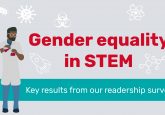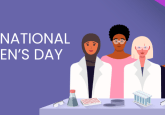A journey through neuroscience: big data and the puzzle of dementia resilience


Becky Carlyle’s (University of Oxford, UK) research focuses on transcriptomics and mass-spectrometry proteomics in human brains to understand the molecular changes that leave some susceptible to dementia and identify disease-progression biomarkers.
In this interview, Becky speaks with Jade Parker (Contributing Editor of Neuro Central) about the importance of diverse big data in Alzheimer’s research, strategies to allow more women to advance in neuroscience including changes in fellowship rules and the role mentorship has played in her career development.
What motivated you to pursue a career in neuroscience and how have you overcome challenges along the way?
I think my ongoing interest in neuroscience is a result of inspiring mentors and the “never-ending” types of questions we get to answer here. When I began my medical training at Oxford, I really hadn’t realised that a scientist was a thing I could be – no one I knew was a scientist, and it wasn’t something that has ever been mentioned during my education. Oxford opened my eyes to the exciting world of research, and there was no going back. The discussions I had as an undergraduate with Sharon Eastwood (now in science writing at Bayer in Basel, Switzerland), Zoltan Molnar (University of Oxford) and Paul Harrison (University of Oxford) really shaped my future interests. I was not only interested in asking on a basic level how the human brain works, but also in how we can use detailed analysis of post-mortem tissue from humans with brain disorders to help improve their lives. All these three individuals had spent a substantial amount of their careers doing just this – I just added some new techniques. Now I’ve travelled full circle and collaborate with both Zoltan and Paul. It’s a dream come true.
Challenges are also mostly overcome by mentorship and connections with peers. Just as I’d navigated blips in funding and really started to compete independently in the USA, the pandemic led to my return home to the UK and having to learn it all over again. You have to talk to people to learn about strategy, pitfalls, and sometimes, just to share the pain. I have to give thanks to Richard Wade-Martins (University of Oxford), for being the main person to support me through securing a Fellowship to continue my work in the UK.
How important has mentorship been in your career? Any notable role models or organisations who influenced your journey?
I’ve spoken about the mentors that started me out on my journey, but I wouldn’t have made it this far without the support of a number of mentors in the USA. There’s no one mentor that can cover all situations, but you need to be proactive in finding your team – some mentors are useful for specific career transitions, others will always be there to help out with interesting ideas and tricky paper rebuttals.
At Yale School of Medicine (CT, USA), Amy Arnsten helped rescue me from a difficult situation, finding me a new lab to move to when an old Principal Investigator left academia, and providing a striking example of the incredible work that can be done with extreme focus and a huge knowledge base. Angus Nairn (also Yale) was the most spectacular scientific mentor – the whole lab would spend hours on a Friday afternoon dissecting raw data, planning new experiments, and ensuring our data was telling us what we thought it was. That was where I really learned how to plan an experiment, and how to write a persuasive grant. When I moved to Massachusetts General Hospital (MA, USA) Steven Arnold opened up a whole new world to me, thinking more about patients, the huge amount of variability they bring with them, and really bringing into focus the idea that neurological disease is not a monolith. All of these experiences combined to send me down a really interesting career path! Since returning to the UK, I’ve found Alzheimer’s Research UK to be a fantastic organisation to work with. Through their regional networks and exceptional grant feedback systems, they are really working hard to support early career researchers.
Are there specific policies that you believe could enhance the work of women in neuroscience?
So many organisations claim to offer flexibility in timelines and grants, particularly for maternity leave, but so frequently I’ve found that to be window dressing. Once you have a child, you tend to be fixed in a location, and your productivity and ability to go the extra mile at work suffers for much longer than the year of allowance you are usually given. Fellowships that prefer you to start over in a new location to demonstrate independence are difficult for many women. We are doing much better at more junior levels at keeping women in the field, but there is still a huge drop off in retention around the age we tend to have children. I’d like to see all “eligible until X years after PhD” rules dropped from grants and fellowships, and different metrics developed for measuring independence outside of physical location.
Your research focuses on understanding why some individuals with high levels of amyloid build-up do not develop dementia. Could you discuss any findings regarding the proteins that contribute to resilience in these individuals?
We’re still right in the middle of a very large proteomics experiment, so I don’t have a huge amount to share at this moment. However, a very talented MSc rotation student, Georgia Morgan, who worked with my lab last summer re-analyzed some of my old peptidomic data, and she drew a link towards retention of somatostatin signalling in people with resilience to amyloid pathology, whereas these signals are lost in dementia (a preprint of the research can be found here). The week that she defended her project thesis, Li-Huei Tsai’s group at MIT (MA, USA) (along with many others) released a huge single-cell sequencing paper in Cell that highlighted somatostatin interneurons as being lost in dementia compared to resilience. Georgia is about to submit her paper that agrees with this finding shortly – it’s really exciting when two groups arrive at the same conclusion from very different directions. So, I think it’s time to start paying more attention to these interneurons.
 World Alzheimer’s Day: accessible Alzheimer’s research
World Alzheimer’s Day: accessible Alzheimer’s research
A compilation of plain language summaries relating to Alzheimer’s disease from Neurodegenerative Disease Management.
Could big data help elucidate potential therapeutic targets from this research and if yes, in which ways is it most useful?
Oh absolutely! This all comes back to the idea that Alzheimer’s Disease is no monolith – the end point may be amyloid and tau pathology, but I strongly believe there are multiple routes to get there. The only way to understand how one case of Alzheimer’s may differ from another is big data. Only by integrating biofluid proteomics, tissue proteomics and transcriptomics with detailed clinical demographic, genetic, and behavioural data, can we begin to answer these questions. This is why studies like UK Biobank are so important – it’s no longer enough to compare a brain with AD pathology to another without. We need to know about their clinical trajectory, their risk factor profile, and ideally, how their biofluids looked over life. And to answer these questions about different paths to disease, we need thousands of data points.
My final point should be that we need more diverse big data. Currently, these huge resources are extremely low in racial and socioeconomic diversity. It’s on us as scientists to build trust with diverse populations and bring them into big research, and to collaborate world-wide to ensure that everyone is represented in our work.
Interviewee profile:
Becky is an Alzheimer’s Research UK Senior Research Fellow and Group leader in the Kavli Institute for Nanoscience Discovery and Department of Physiology, Anatomy & Genetics at the University of Oxford. Her current research focuses on integration of global measures of RNA (transcriptomics) and protein (mass-spectrometry proteomics) in the post-mortem human brain to understand the molecular changes that leave us susceptible to dementia and identify biomarkers of disease progression.
Prior to beginning her fellowship in 2022, she was the Associate Director of the Biomarkers Cores at the Massachusetts Alzheimer’s Disease Research Center (MA, USA) and the Harvard Aging Brain study, where she used mass-spectrometry and antibody-based approaches to develop novel biomarkers for the molecular changes that commonly occur with Alzheimer’s Disease.
The opinions expressed in this article are those of the author and do not necessarily reflect the views of Neuro Central or Taylor & Francis Group.





